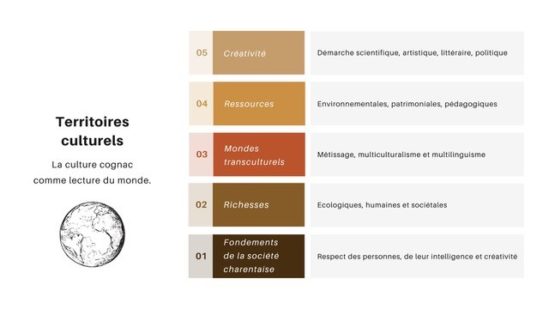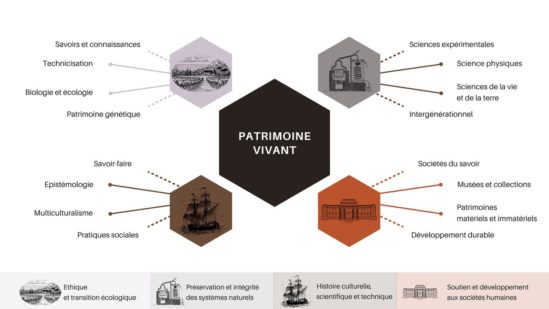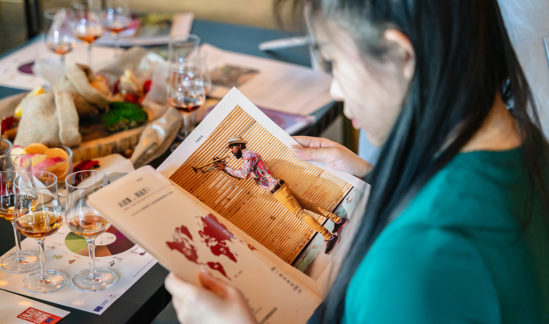Conversations with Vanessa Ferey, in charge of Cognac’s intangible cultural heritage and ethnology.
Exported 97% of the time, Cognac is a spirit that represents France in every corner of the globe.
In the company of Vanessa Ferey, in charge of Cognac’s intangible cultural heritage and ethnology, we take a look at Cognac’s application to become an intangible cultural heritage site under the UNESCO Convention.
As the person in charge of the project to have Cognac included in the national inventory of intangible cultural heritage under the UNESCO Convention, could you tell us about your objectives?
For a number of years now, those involved in the Cognac appellation, both in the region and in the industry, have been working to have Cognac included on UNESCO’s Representative List of the Intangible Cultural Heritage of Humanity. I joined the association behind the project with the conviction that the specific characteristics of this unique spirit are a real asset in deserving such a listing.
But beyond the classification itself, the UNESCO application process aims to be a decision-making tool that can be used by the various players involved in local development (local politicians, regional developers – wine/spiri-tourism, culture, training, etc.) to help maintain the vitality of the Cognac production chain.
One of the association’s cultural and scientific objectives is to advance knowledge of Cognac’s rich heritage. Making the intangible culture of Cognac part of our heritage is therefore another way of thinking about science and culture in the light of economic and social issues, existential and societal questions, and the ethical and environmental concerns of an entire community.

© Marius W. Hansen
What are the issues behind preserving a “Cognac culture”?
The ways in which knowledge is transferred evolve according to the territorial expectations of the regions, but also according to the ways in which knowledge is preserved in the professional circles involved in the production of Cognac eau-de-vie.
A theoretical framework and analytical methods based on systems thinking are used here to model a ‘Cognac culture’ in order to facilitate understanding of the complex cultural phenomena specific to it, such as the dynamics of its social relations in an intercultural and transcultural context.
The knowledge and know-how associated with the traditional family crafts used to make this eau-de-vie are above all living knowledge, rooted in a professional interculturality. This interculturalism is developing in parallel with another epistemological phenomenon aimed at satisfying, admittedly, commercial issues, but ultimately supporting the cause of multiculturalism, the origins of which are in fact linked to the recent concept of ‘superdiversity’ in connection with the study of the phenomena of heterogeneity and cultural pluralism.
Today, the major social, cultural, religious and linguistic issues linked to the preservation of this ‘Cognac culture’ highlight so many phenomena of the same type which combine with others such as gender or age and legal status, two major subjects in the production of Cognac brandy and its marketing. We draw on the work of Steven Vertovec (2022), who refocuses the scientific project of anthropology around the central issue of the ‘change of change’ explored by the anthropologist Gregory Bateson.
Within the framework of a general theory of communication, we could thus explain the movements of adaptation and mutation of the ‘spirit’ of human societies (1972) linked to the tangible and intangible heritage of Cognac since the seventeenth century.
How does Cognac culture, its social interactions, its knowledge and know-how contribute to the preservation of intangible cultural heritage ?
The cultural areas of Cognac are part of an extremely diverse region, with a rich heritage representing a wide range of traditions, but also bearing witness to this formidable human adventure which has contributed to the humanist and universalist foundations of our contemporary society.

©Vanessa Ferey
Archives, artefacts, life stories – all these tangible and intangible traces can contribute in many ways to achieving the objectives of our application: whether it’s supporting the restoration of heritage sites, raising awareness of the challenges of sustainable development or encouraging the teaching of science and technology.
The application for recognition of the intangible cultural heritage of Cognac eau-de-vie as part of the common heritage of humanity is an opportunity to consider a cultural heritage system that is unique to the Charentes region and that has received little international recognition to date.
The theoretical object that we are attempting to form here is intended to support and guide a community of practitioners, professionals and researchers in modelling difficult problems, such as the growing complexity of intercultural relations in international spirits markets. The study of such a ‘cultural system’ concerning Cognac’s heritage takes time. It is necessary to examine the interconnections needed to maintain its organisation (structure), the operating methods of its internal intelligence (functioning), and its readiness to change (processes). The creation of an association to gather together the foundations of the vast study of Cognac’s human cultures is a fundamental step forward in the life of its communities wishing to declare a heritage in the eyes of humanity.

©Vanessa Ferey
Winegrowers, distillers and cellar masters pass on a unique cultural history from generation to generation, ensuring that a living culture continues to thrive and that an exceptional heritage is passed on to future generations.
What are the criteria for an item to be listed as intangible cultural heritage by UNESCO?
The criteria for an element to be listed as intangible cultural heritage by UNESCO are : traditional, contemporary and, above all, living, since the heritage to be listed must not only include traditions inherited from the past; it must be inclusive, since the expressions of the intangible cultural heritage of cognac culture may be similar to those practised by others throughout the world; be representative because the cultural asset that cognac represents develops from its roots in the communities that make up its sector and therefore depends on the transmission of knowledge of the traditions, know-how and customs of those involved passed on to other communities; based on the communities that create, maintain and transmit cognac, without the opinion of the latter, cognac cannot be an expression or practice given as constituting their heritage.
How is the decision taken to include an element in UNESCO’s intangible cultural heritage?
First of all, the candidate files are examined by the Comité du Patrimoine Ethnologique et Immatériel (CPEI) of the French Ministry of Culture, which decides, depending on the progress of the project, whether or not to transmit the files to UNESCO or to request additional information. If necessary, the CPEI can also interview the project leaders. The inclusion of an element in UNESCO’s intangible cultural heritage is then decided at meetings of the Intergovernmental Committee for the Safeguarding of the Intangible Cultural Heritage. States party to the Convention may propose elements for inclusion, and the Committee assesses their conformity with the established criteria.
What are the advantages of being listed as a UNESCO intangible cultural heritage?
Inclusion in Unesco’s intangible cultural heritage list means that the culture of Cognac can be safeguarded, maintained, enhanced and passed on. Official recognition as an intangible cultural heritage site will give new impetus to our international cultural exchanges, and to the history of Cognac. Admittedly, it will also give us greater visibility to encourage a sustainable development approach to issues such as health, food safety, quality education, inclusive economic development, gender equality, environmental sustainability including climate change, and peace and social cohesion.

©Cliff Ching
How does Cognac stand out as a cultural phenomenon?
As I said earlier, the ‘superdiversity’ of Cognac is a really interesting dimension for the classification.
This ‘superdiversity’ adopted by social science academics is a key point of interest in the study of Cognac’s heritage abroad, which is also in line with the migratory patterns of our social history, from the Charentes to the Americas, via the West Indies, in the case that interests us here.
In the United States, Cognac is writing a large chapter in its incredible saga. It has become a marker of “identity, popularity and inspiration” (Revue des deux mondes, 2022), contributing to an economic and geopolitical adventure that aims to adapt and reinvent itself thanks to the ingenuity of the communities that not only create it, but also gather around it.
This phenomenon of identity around the spirit can be found in other communities on the Asian, African and European continents, and on each of these continents, the relationship with Cognac and its consumption patterns adopt their own narratives in a totally cosmopolitan spirit.
In conclusion, I would be tempted to say that there is not “one” Cognac culture, but “many” Cognac cultures.




